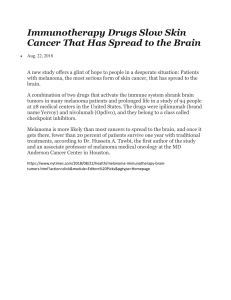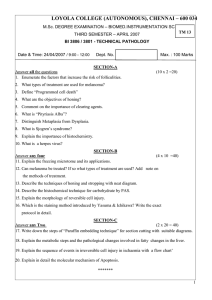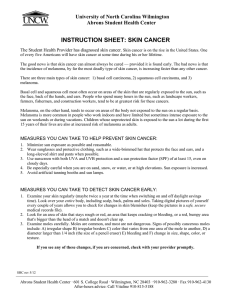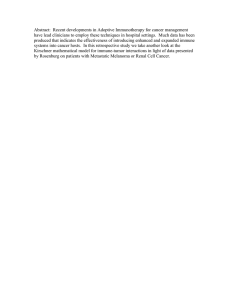IRJET-Detection & Classification of Melanoma Skin Cancer
advertisement
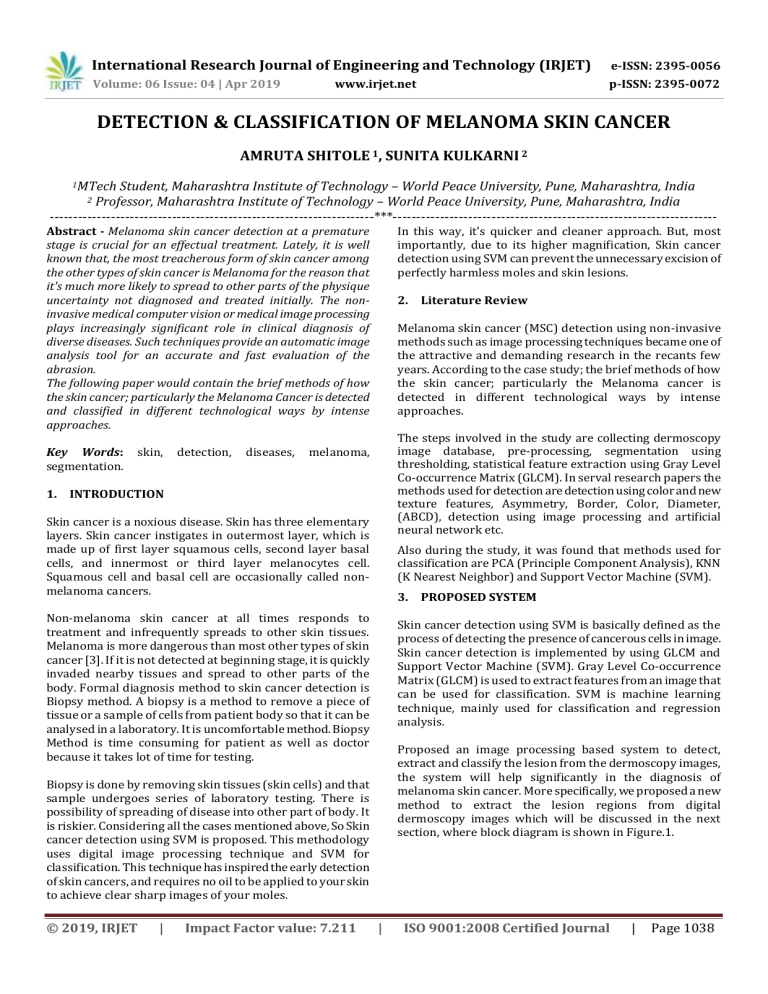
International Research Journal of Engineering and Technology (IRJET) e-ISSN: 2395-0056 Volume: 06 Issue: 04 | Apr 2019 p-ISSN: 2395-0072 www.irjet.net DETECTION & CLASSIFICATION OF MELANOMA SKIN CANCER AMRUTA SHITOLE 1, SUNITA KULKARNI 2 1MTech Student, Maharashtra Institute of Technology – World Peace University, Pune, Maharashtra, India Professor, Maharashtra Institute of Technology – World Peace University, Pune, Maharashtra, India ---------------------------------------------------------------------***--------------------------------------------------------------------2 Abstract - Melanoma skin cancer detection at a premature stage is crucial for an effectual treatment. Lately, it is well known that, the most treacherous form of skin cancer among the other types of skin cancer is Melanoma for the reason that it's much more likely to spread to other parts of the physique uncertainty not diagnosed and treated initially. The noninvasive medical computer vision or medical image processing plays increasingly significant role in clinical diagnosis of diverse diseases. Such techniques provide an automatic image analysis tool for an accurate and fast evaluation of the abrasion. The following paper would contain the brief methods of how the skin cancer; particularly the Melanoma Cancer is detected and classified in different technological ways by intense approaches. Key Words: segmentation. skin, detection, diseases, In this way, it's quicker and cleaner approach. But, most importantly, due to its higher magnification, Skin cancer detection using SVM can prevent the unnecessary excision of perfectly harmless moles and skin lesions. 2. Literature Review Melanoma skin cancer (MSC) detection using non-invasive methods such as image processing techniques became one of the attractive and demanding research in the recants few years. According to the case study; the brief methods of how the skin cancer; particularly the Melanoma cancer is detected in different technological ways by intense approaches. The steps involved in the study are collecting dermoscopy image database, pre-processing, segmentation using thresholding, statistical feature extraction using Gray Level Co-occurrence Matrix (GLCM). In serval research papers the methods used for detection are detection using color and new texture features, Asymmetry, Border, Color, Diameter, (ABCD), detection using image processing and artificial neural network etc. melanoma, 1. INTRODUCTION Skin cancer is a noxious disease. Skin has three elementary layers. Skin cancer instigates in outermost layer, which is made up of first layer squamous cells, second layer basal cells, and innermost or third layer melanocytes cell. Squamous cell and basal cell are occasionally called nonmelanoma cancers. Also during the study, it was found that methods used for classification are PCA (Principle Component Analysis), KNN (K Nearest Neighbor) and Support Vector Machine (SVM). 3. PROPOSED SYSTEM Non-melanoma skin cancer at all times responds to treatment and infrequently spreads to other skin tissues. Melanoma is more dangerous than most other types of skin cancer [3]. If it is not detected at beginning stage, it is quickly invaded nearby tissues and spread to other parts of the body. Formal diagnosis method to skin cancer detection is Biopsy method. A biopsy is a method to remove a piece of tissue or a sample of cells from patient body so that it can be analysed in a laboratory. It is uncomfortable method. Biopsy Method is time consuming for patient as well as doctor because it takes lot of time for testing. Skin cancer detection using SVM is basically defined as the process of detecting the presence of cancerous cells in image. Skin cancer detection is implemented by using GLCM and Support Vector Machine (SVM). Gray Level Co-occurrence Matrix (GLCM) is used to extract features from an image that can be used for classification. SVM is machine learning technique, mainly used for classification and regression analysis. Proposed an image processing based system to detect, extract and classify the lesion from the dermoscopy images, the system will help significantly in the diagnosis of melanoma skin cancer. More specifically, we proposed a new method to extract the lesion regions from digital dermoscopy images which will be discussed in the next section, where block diagram is shown in Figure.1. Biopsy is done by removing skin tissues (skin cells) and that sample undergoes series of laboratory testing. There is possibility of spreading of disease into other part of body. It is riskier. Considering all the cases mentioned above, So Skin cancer detection using SVM is proposed. This methodology uses digital image processing technique and SVM for classification. This technique has inspired the early detection of skin cancers, and requires no oil to be applied to your skin to achieve clear sharp images of your moles. © 2019, IRJET | Impact Factor value: 7.211 | ISO 9001:2008 Certified Journal | Page 1038 International Research Journal of Engineering and Technology (IRJET) e-ISSN: 2395-0056 Volume: 06 Issue: 04 | Apr 2019 p-ISSN: 2395-0072 www.irjet.net 4.2. Pre-processing This step includes Converting the RGB acquired skin image to gray image, Contrast enhancement, Histogram modification and, Noise Filtering. Contrast enhancement and histogram modification are proposed since some of the acquired images are not homogenous due to incorrect illumination during the image acquisition. While the histogram modification techniques such histogram equalization is used to enhance the contrast of the image and, therefore, making the segmentation more accurate. Noise filtering using median filter is implemented to reduce the impact of hair cover on the skin in the final image used for classification Fig -1: The projected system block diagram. 4.3. Image Segmentation 4. METHODOLOGY Image segmentation is an essential step for analyzing the image, as it differentiates between the full skin and the concerned lesion. The images that made up our dataset were not modified and were kept in their original size and resolution. The process of segmenting an image is not that simple as there is a great variety in skin type, lesion shape and the form of boundaries. In order to classify a skin image as cancerous or not, we followed a specific methodology. Initially, the image of the mole was segmented using thresholding, then ABCD technique was applied to the segmented image to extract the feature. Finally, SVM (support vector machine) algorithm was used to determine whether the mole is cancerous or not based on the extracted features. Fig 2 shows the general overview of this methodology. The images used were acquired from the demurest and dermis datasets. In our proposed technique, segmentation was done using thresholding, by firstly getting the binary form of the original image (a) and then converting it to gray scale (b). We then extracted the edges of the lesion as shown in (c). The final step was to obtain one connected component which represented the lesion. The latter allowed us to attain an image (d) which was then used for feature extraction in fig 3. Feature Extraction Certain geometrical characteristics of the lesion can indicate the presence of melanoma skin cancer. Following the segmentation of the skin image, we could extract four different attributes that fall under the ABCD features. Fig -2: Methodological flow of proposed system 4.1. Image Database The database was generated by collecting images from different websites with known category (Normal/Melanoma). These websites are specified for melanoma skin cancer. Fig -3: Methodological flow of proposed system © 2019, IRJET | Impact Factor value: 7.211 | ISO 9001:2008 Certified Journal | Page 1039 International Research Journal of Engineering and Technology (IRJET) e-ISSN: 2395-0056 Volume: 06 Issue: 04 | Apr 2019 p-ISSN: 2395-0072 www.irjet.net hyper plane f(x) that passes through the middle of the two classes, separating the two. SVMs were initially developed for binary classification but it could be efficiently extended for multiclass problems. 4.4. ABCD Feature Extraction ABCD is an acronym to Asymmetry Border Irregularity Color variation and Diameter. Feature extraction for melanoma skin cancer detection. CONCLUSIONS In melanoma skin cancer the lesion have asymmetricity and have an irregular border with red shaded skin which further with complexity grows to red blue black and so on; and along with that the diameter spared greater than 6mm, so during melanoma skin cancer detection this feature extraction is very important. Following are the core plus points of the implementation of the detection & classification of this particular skin cancer called Melanoma: • The exact position of the pretentious area is traced. • Skin cancer can be detected professionally. • Operators will have the benefit of the automatic detection of the skin cancer. • The system is not costly and hence can be used by a large number of individuals in addition it can be instigated in rural area also. 4.5. Classification In classification, we categories between cancerous and noncancerous skin images. There are serval technics in classification; such as decision tree, Nearest Neighbor, Support Vector Machine(SVM) and neural networks. Automated digital image processing system play very important role in medical diagnosis extracting a feature like asymmetry, border, color and diameter efficiently. And by using PCA (Principal component analysis) select the best features with maximum efficiency then according to that feature SVM (Support vector machine) classify image is cancerous or noncancerous. Among these SVM is the best technic for implementing the judgement of melanoma skin cancer. SVM leads due to its advantage that it is useful for non-linear separable data. 5. Principal Component Analysis (PCA) The feature extracted from the 4 phases above (contrast, skewness, kurtosis, energy, mean, standard deviation, circulation, energy, correlation, homogeneity and TDS value) are fed into PCA. Since some of the features maybe ineffective on accuracy beside to the time required for accurate classification. PCA is used to reduce the number of features, due to the different units in the feature set. The PCA uses the correlation matrix instead of the covariance matrix. After implementing this operation and calculation of eigenvalues and variances, set of main components is obtained which are arranged based on their ability to distinguish between benign and malignant lesions. REFERENCES [1] Pratik Dubal, Sankirtan Bhatt, Chaitanya Joglekar, Dr. Sonali Patil “Skin Cancer Detection and Classification”, 2017 IEEE. [2] Shivangi Jaina, Vandana jagtapb, Nitin Pisea,b“Computer aided Melanoma skin cancer detection using Image Processing” Procedia Computer Science 48 ( 2015 ) 735 – 74. [3] Rebecca Moussa, Firas Gerges, Christian Salem, Romario Akiki, Omar Falou, and Danielle Azar “Computer-aided Detection of Melanoma Using Geometric Features”, 2016 3rd Middle East Conference on Biomedical Engineering (MECBME),2016 IEEE. To determine the number of features which are lead to the best classification result, we store the features and their efficiency were checked during classification. Finally, we have selected the best 5 features with maximum efficiency as follows: TDS, mean, standard deviation, energy, and contrast respectively. [4] Er.Shrinidhi Gindhi, Ansari Nausheen, Ansari Zoya, Shaikh Ruhin “An Innovative Approach for Skin Disease Detection Using Image Processing and Data Mining” Vol. 5, Issue 4, April 2017.pp 8135-8141. 6. Classification using SVM Support Vector Machine (SVM) SVM is a very effective method for regression, classification and general pattern recognition. It is considered a good classifier because of its high generalization performance without the need to add a priori knowledge, even when the dimension of the input space is very high. It is considered a good classifier because of its high generalization performance without the need to add a priori knowledge, even when the dimension of the input space is very high. For a linearly separable dataset, a linear classification function corresponds to a separating © 2019, IRJET | Impact Factor value: 7.211 [5] G.Kesavaraj, Dr.S.Sukumaran “A Study On Classification Techniques in Data Mining” IEEE – 31661 July 4 - 6, 2013, Tiruchengode, India. [6] Mr. Sudhir M. Gorade, Prof. Ankit Deo , Prof. Preetesh Purohit “A Study of Some Data Mining Classification Techniques ” Volume: 04 Issue: 04 , Apr -2017 IRJET, pp 3112-3115. | ISO 9001:2008 Certified Journal | Page 1040 International Research Journal of Engineering and Technology (IRJET) e-ISSN: 2395-0056 Volume: 06 Issue: 04 | Apr 2019 p-ISSN: 2395-0072 www.irjet.net [7] Dalia N. Abdul-wadood, Dr. Loay E. George, Dr. Nabeel A. Rasheed, “Diagnosis of Skin Cancer Using Image Texture Analysis” International Journal of Scientific & Engineering Research, Volume 5, Issue 6, June-2014. [8] Rahat Yasir,Md. Ashiqur Rahman, and Nova Ahmed “Dermatological Disease Detection using Image Processing and Artificial Neural Network”, 8th International Conference on Electrical and Computer Engineering 20-22 December, 2014, Dhaka, Bangladesh. [9] NishaYadav,Virender Kumar Narang ,Utpalshrivastava “Skin Diseases Detection Models using Image Processing: A Survey”, International Journal of Computer Applications (0975 – 8887) Volume 137 – No.12, March 2016 . [10] A.A.L.C. Amarathunga, E.P.W.C. Ellawala, G.N. Abeysekara, C. R. J. Amalraj “Expert System For Diagnosis of Skin Diseases”, International journal of scientific & technology research volume 4, issue 01, january 2015. [11] C.B. Tatepamulwar, V.P. Pawar, K.S. Deshpande,H. S. Fadewar, “Detection and Identification of Human Skin Diseases Using CIE lab Values”, June 6,2016. © 2019, IRJET | Impact Factor value: 7.211 | ISO 9001:2008 Certified Journal | Page 1041
